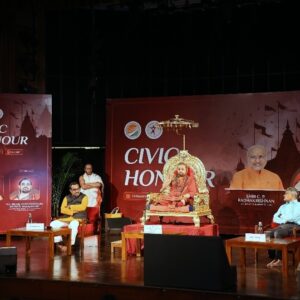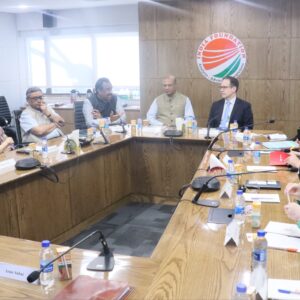A small India Foundation team went to Iran as part of a larger ICCR delegation to participate in an International Conference ‘India-Iran, Two Great Civilizations; Retrospect and Prospect.’ This conference was inaugurated by Hon’ble Prime Minister Shri Narendra Modi on February 23rd. The local host was the Iranian language and culture institute (Farhaang-e-Jabaan-o-Adab-e-Farsi), which is part of the Sa’adi Foundation; both are headed by Prof Hadaad Adel, a close relative of the Supreme Leader.
Since the focus of the Conference as well as inclination of the local host was ‘Culture’, functionally the conference was split up into two. The India Foundation team participated in the inaugural and also spoke at the opening (S/Shri NK Singh, Jay Panda and Shakti Sinha) where the political, economic and strategic dimensions of the relationship, going forward, were highlighted. Basically with the adoption of the Joint Comprehensive Plan of Action (JCPOA), which resulted from the successful culmination of the P5+1 nuclear talks, Iran is more or less open to business. (However, non-nuclear sanctions imposed on Iran relating to its sponsorship of terrorism, support to Hezbollah etc. are still in place).
After the opening session, the India Foundation team went to the Centre for Scientific Research and Middle East Strategic Studies and met its DG. It is a fairly large institute with over 70 employees including 30 young researchers. Its remit covers the region from Turkey to India and beyond, and takes out a quarterly (Discourse) in Farsi, Arabic and English. The gist of their point of view was that Iran was key to peace and stability in the region, that the great powers (P5+1) negotiated with them, and that the US would have no option but to engage with Iran even more. India was seen as a friend, who continued to buy oil despite sanctions; however, pending payment issues was pointedly mentioned. We were asked couldIndia assist Iran in the field of IT and IT-enabled services (ITES)? DG ICCR responded by saying that he could offered 1-2 scholarships from Iranian students as early as the academic session beginning July 2017. The Centre, which can be said to represent conservative elements, is keen establish institutional links with India Foundation. One key take-away was that while the Centre presented an exaggerated notion on Iran’s importance, it was clear that it was the US which would continue to be the most important power for some time to come. And that India-Iran partnership including economic could play an important role in the region.
Later the delegation had a detailed meeting with a large group of diplomats and scholars convened by Centre for International Education and Research (CIER), presided over by its Head, Dr HadiSolaimanpour. This centre is part of Iran’s foreign ministry, a combination of a training institute and think tank. The only area studies program they have is on the subcontinent. Also present was a representative from the Institute for Political and International Studies (IPIS) a foreign ministry think tank and from Tehran University’s India Studies department. IPIS functions under the control and guidance of the CIER whose head is part of the decision-making apparatus. IPIS has a number of study groups and takes out journals in Farsi, Arabic, English and Russian. It also has institutional linkages with Institute of Defence Studies and Analysis (IDSA) and with Vivekanand International Foundation (VIF), holding periodic bilateral discussions with them.
This was a very detailed meeting with a lot of history and analysis offered by senior diplomats, retired and serving, including a former Ambassador to India. Delays in finalisation of the Chahbahar agreement was laid at India’s door acting under American pressure, though Iran is actually as much responsible for putting the project on the backburner. Another point of view was that India should make up with Pakistan. Overall, India’s economic engagement was welcomed, and criticised for not being bold enough. A number of them expressed the need to have more non-official bilateral dialogue between the two countries and IPIS seemed open, though they are already present here, as mentioned. Tehran university representative also expressed her desire for more support from India.
The last substantive meeting was with Mr MoucherMottaki, a former foreign minister who has studied in Bengaluru. Though Mr Mottaki was President Ahmednijad’s FM who was dismissed by the Majlis (Parliament) and holds no official position, the meeting was held in the formal calling-on room at the CIER, reflecting Iran’s complex governing arrangements where the link between power and official position is often absent and generally confusing. It is said that at the time of the last Presidential elections, Mr Mottaki wanted to contest but was prevented/ dissuaded and may offer himself in the next elections due in 2017.
Mr Mottaki stressed Iran’s credentials in fighting terrorism, saying it made no distinction between ‘good’ and ‘bad’ terrorists, and said that freed of third party (read USA) influence, bilateral relations should take-off. He was particularly keen on Indian technologies as more relevant to Iran’s needs and, in view of his point that while ISIS may be defeated its ideology would persist to attract people, open to suggestions that India and Iran work to developing an alternative moderate narrative for the Muslim youth. He had taken a very hawkish line on India when it voted along with others to refer the Iran nuclear issue to the UN Security Conference, but seems to have got over it, referring repeatedly to India’s democratic institutions that were non-discriminatory and allowed all to participate freely.
Conclusion: There is no doubt that India Foundation should engage vigorously with Iran, particularly help develop a geopolitical narrative that is in India’s national interest, and in ensuring that Chahbahar and all related projects are delivered in time. Iran is extremely European-US in its orientation, and economically much more engaged with India. However, closer economic ties would be mutually beneficial as (i) Indian entrepreneurship and technology would help push up Iran’s economy whose growth rates is stuck, and (ii) Iran represents not just India’s access to Afghanistan and Central Asia but key to developing a dense network of economic ties (trade, joint ventures, mineral exploration) that would anchor the region around regional ties.
The choice of partner/s can be finalised after getting feedback from those better informed.



